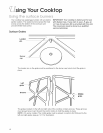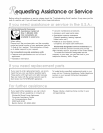
singYourCookfop
Your cooktop is designed for easy care. However,
you need to maintain your ceramic glass surface
differently than you would standard porcelain or
glass surfaces. Foods spilled directly on the cooktop
will not burn off. You should keep the surface dust
free and soil free before heating.
The surface has been prepolished at the factory for
improved protection and easier cleaning. The
Cooktop Polishing Creme included with your
cooktop, paper towels or a sponge, and a single-
edge razor blade in the holder are all you need to
clean your cooktop. For proper cleaning methods,
please review "Cleaning tips" later in this section.
Follow them each time you use your cooktop. This will
ensure you get the best performance out of your
cooktop, as well as preserve that uniquely elegant look.
NOTE: Let the surface cool before cleaning.
To avoid damaging the surface, follow these
instructions:
®Remove sugar spills and soils from the cooktop
while the surface is still warm to avoid pitting on
the surface.
o Do not use steel wool, plastic cleaning pads, gritty
powdered cleansers, chlorine bleach, rust remover,
ammonia, or glass cleaning products with ammonia.
These could damage the cooktop surface.
CNeaning tips
What to use:
o Cooktop Polishing Creme included with your
cooktop with a paper towel or clean, damp sponge.
This creme has been developed especially for
cleaning and polishing your cooktop. When using,
follow instructions on container.
®Razor scraper - Use to remove cooked-on soils
from your ceramic glass cooktop. To avoid
scratches, keep the razor blade as flat against the
cooktop as possible. Do not use on porcelain
surfaces. Store razor blades out of reach of
children. (Not included with your range.)
®Do not use steel wool, plastic cleaning pads,
abrasive powdered cleansers, chlorine bleach, rust
remover, ammonia, or glass cleaning products with
ammonia. These products could damage the
cooktop surface.
Steps to fommow:
1. Most spills can be wiped off easily using a paper
towel or clean, damp sponge as soon as Hot
Surface Indicator Light goes off.
2. For stubborn spills, rub Cooktop Polishing
Creme into cooked-on soil using a paper towel If
some soil remains, leave some creme on the
spot(s) and follow Step 3.
3. Carefulmy scrape spots with the razor scraper.
4. Finish by polishing entire cooktop with Cooktop
Polishing Creme and a paper towel
To order Cooktop Polishing Creme (Part No.
9753543) or razor scraper (Part No. 3153458},
call 1-500-422-1235 (in Canada, 1-500-451-5651)
and follow the instructions and telephone prompts
you hear.
NOTE: Always wipe and dry your cooktop thoroughly
after using cleanser to prevent streaking or staining.
How fo keep your cookfop mooking
Hke new:
IF THERE ARE WHAT TO DO
Sugary spills
and soils
(such as
jellies and
candy syrups)
To prevent pitting on the cooktop,
wipe up with a paper towel or
clean, damp sponge while
ceramic glass surface is still
warm. Remove as soon as
possible after spill occurs.
Burned-on
soits
Rub Cooktop Polishing Creme or
nonabrasive cleanser into soil
using a paper towel. Reapply
creme to spots remaining. Hold
razor scraper as flat to surface as
possible, scrape spots. Polish
entire cooktop with creme and
paper towel. Rinse and dry. Store
razor blades out of reach of
children.
Dark streaks, Use Cooktop Polishing Creme or
specks, and nonabrasive cleanser with a damp
discoloration paper towel or sponge.
Metal marks
(from copper
or aluminum
pans)
Use Cooktop Polishing Creme or
nonabrasive cleanser with a damp
paper towel or sponge before
heating the cooktop again. If
heated before cleaning, metal
marks may not come off.
Tiny
scratches or
abrasions
Scratches and abrasions do not
affect cooking. In time, they will
become less visible as a result of
cleaning. To prevent scratches
and abrasions, use Cooktop
Polishing Creme regularly.
15


















